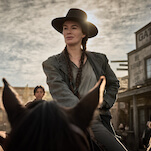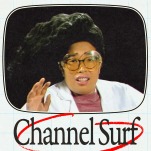With so many new series popping up on streaming services and DVD every day, it gets harder and harder to keep up with new shows, much less the all-time classics. With TV Club 10, we point you toward the 10 episodes that best represent a TV series, classic or modern. If you watch those 10, you’ll have a better idea of what that series was about, without having to watch the whole thing. These are not meant to be the 10 best episodes, but rather the 10 most representative episodes.
Television is littered with shows that depict epic events on vast scales. Presidential assassinations, zombie breakouts, and multigenerational gang warfare are certainly ways to create conflict, reveal character, and inspire loyal viewership. But there are also plenty of ways to do those things while staying small in scope. For instance, Cougar Town is decidedly not a show with large dramatic stakes. But the show’s supposed smallness is actually deceiving: Even without worldwide consequence hanging in the balance, Cougar Town deals with issues of family, loyalty, and the pursuit of happiness, not as individuals, but as part of the larger fabric of society.
To pull that off within a comedic structure on a weekly basis, Cougar Town by necessity focuses on a small slice of that overall fabric. At the center of what is affectionately known as the “Cul-de-sac Crew” (named for the enclave in which many of the show’s characters live) is Jules Cobb (Courteney Cox), who at the start of the show is a recently divorced mother. Co-creators Bill Lawrence and Kevin Biegel initially conceived the show as a star vehicle for Cox after coming up with the title as a gag inside the writer’s room of Scrubs. But attempts to make the show work as a literal interpretation of the title yielded instantly unsatisfying results. Only by repositioning the series as a meditation on adult friendship (and copious amounts of wine) did it start to find itself.
Cougar Town pivoted almost instantly away from Jules chasing younger men to her serving as the mother hen to not only her son Travis (Dan Byrd) and ex-husband Bobby (Brian Van Holt), but also her married neighbors Andy and Ellie Torres (Ian Gomez, Christa Miller), her co-worker Laurie (Busy Philips), and her likewise newly divorced neighbor Grayson (Josh Hopkins). Little of dramatic consequence happens in each episode, but the show’s power lies in developing each character and his or her relationship to the others. It’s a gradual move, one nearly imperceptible until the viewer steps back and sees how far each character has actually progressed over the course of a season. Also? There’s wine. So, so, so much wine.
Jumping right into the series when it kicks off its TBS run this month won’t leave anyone struggling to understand the basic dynamics of the show, which should be obvious even to first-time viewers. But what will be lost are not only the callbacks to running gags and phrases that have accumulated over time, but also how each member of the Cul-de-sac Crew contributes to its small society. On the surface, it may seem like these people don’t even seem to like each other that much. But the mockery, barbs, and interferences in each other’s lives carry a deeper meaning the longer viewers watch. Each member of this makeshift family knows the weak spots of every other member, but they also all understand how to comfort and protect that individual when needed. Just below the surface of this show is a fairly deep melancholic strain. That’s not obvious when the group invents ever-more-elaborate rules for their favorite game, “Penny Can.” (It’s just what it sounds like.) But it’s perfectly clear when the sarcastic façades fade away when one of the crew is in emotional straits.
While Cougar Town isn’t plot-heavy, its character-driven nature lends itself to certain signpost episodes that either represent the group dynamics at their purest or feature moments in which those dynamics radically (and permanently) change. The 10 episodes below serve to highlight those signposts for newcomers. With only three seasons and 61 episodes to get through, it’s perfectly possible to blaze through the entire series in a week. But for those looking for a sampler of what makes this one of the most underrated shows on television, here’s where to start.
“Don’t Come Around Here No More” (season one, episode seven): Forget the first half-dozen episodes, which focus on Jules’ ill-advised search for younger men, and skip directly to the episode in which the show figures out a potential path going forward. Grayson bets Jules that she can’t spend 24 hours alone. Desperate to win the bet, but even more desperate to have her friends around her, Jules sneaks over one member of the Cul-de-sac Crew after another, until finally the gang is fully assembled in her house. This episode not only solidifies Jules’ house as the home base for the show, but it also starts the slow transformation of Grayson from acerbic outsider into a full-fledged member of Jules’ makeshift family.
“Here Comes My Girl” (season one, episode nine): Holiday episodes are often high points for sitcoms, as they offer built-in reasons for people to come together, as well as take stock in their own lives. In this Thanksgiving episode, the men come face to face with their age in the form of a yearly basketball game, Jules fears that Travis will follow in her footsteps when it comes to teenage pregnancy, and certain members of the group realize their feelings for another in the group may be more than friendly. In the end, the ragtag crew rallies around the holiday meal, having resolved little but to have each other’s backs as they work through their respective problems. It’s a strong mission statement for the show, albeit one that would take time to unfold consistently.
“Counting On You” (season one, episode 17): Past the halfway point of the first season, Cougar Town had settled on its basic rhythms, with the high-concept premise outlined in the title jettisoned for barely there plots that emphasize character over narrative. This installment takes the hackneyed “can guys and girls be friends” premise and interweaves it with jokes (Grayson’s small eyes) and characters (creepy neighbor Tom) that would become mainstays for the program. This episode also features a fight between married couple Andy and Ellie Torres that helps define the show’s core tenets: While loved ones often bicker, those fights help define relationships as much as test them.
“Finding Out” (season one, episode 24): Someone who only watched the pilot of Cougar Town, then watched this episode, would be forgiven for thinking the same cast had been placed into another show altogether. But that’s a testament to how lived-in the show feels at this point, with relationships that are flexible yet still deeply felt between the members of the Crew. The show is never afraid to occasionally expose the deep undercurrents of sadness in the lives of its characters, particularly when it comes to Bobby Cobb. This episode surrounds everyone’s attempts to hide a major secret from Bobby, and the lengths to which everyone goes to let him down as gently as possible yield some of the show’s finest moments. The fact that Bobby’s most enduring contribution to the show’s world (Penny Can) plays a central role in this deception is only icing on the wine-flavored cake.
“You Don’t Know How It Feels” (season two, episode six): In the first season, Thanksgiving brought the Cul-de-sac crew closer together. In this second-season Halloween endeavor, the holidays allow them to share how they really feel about one another through costume. Oftentimes, this takes the form of simple role reversal, with Ellie and Laurie dressing up as the other in order to take their adversarial friendship to the next level. Bobby’s inventive “Man In The Wind” costume is a great sight gag, but also helps convey the ups and downs he feels about his threatened status as Stan Torres’ legal guardian. But dressing up also affords the opportunity for Jules and her father Chick (played by Scrubs vet Ken Jenkins in what turns into a recurring guest role) to finally talk about a mutual loss. If that weren’t enough, this episode also brings one of the show’s most-debated topics to the forefront: the will-they/won’t-they relationship between Laurie and Travis. While Travis’ crush was played for laughs in the first season, this episode introduces a new note to what eventually becomes an incredibly complex (and incredibly sweet) dynamic between the pair.
“Lost Children” (season two, episode 13): This is the episode where the audience realized that not only was this show different from what it had been, but the characters themselves had also subtly but fundamentally changed. It wasn’t just that Jules no longer sought to sleep with men half her age. Everyone in the Crew looked at both themselves and each other in a different way than they did at the start of the series. A childlike game of Sardines becomes the unlikely lightning rod for the group to pair off in ways normal (Jules and Travis) and unusual (Grayson and Andy) in order to explore those new dynamics. It demonstrates that seismic change need not be precipitated by earth-shattering events. The evolutionary process by which simple, daily interactions shift people’s attitudes and perspectives can be just as much a motivator for change. But it doesn’t simply offer these people up as paragons: While Tom is temporarily let into the inner circle, he doesn’t stay there for long. Change may be inevitable, but it’s rarely easy, even on this show.
“Lonesome Sundown” (season two, episode 18): Travis often serves as audience surrogate within the world of the show, reacting to the insanity around him as viewers might. But he also serves as a focal point upon which the adults in the show project their hopes, dreams, and fears. Each of the characters still have room for growth, but have largely made key decisions that have landed them in the places they currently reside. But Travis? Travis still has his life mostly ahead of him, which makes his ill-advised plan to keep his graduate-student girlfriend from moving to Chicago all the more potentially dangerous. Everyone tries to provide space for Travis to make his own mistakes, going so far as creating The Council as a diversionary tactic to keep their meddlesome nature contained to themselves. But reality comes crashing in for both sides by episode’s end, setting up an arc that would carry through the rest of the season. The arc as a whole is strong, but this is the one that will really break some hearts.
“A One Story Town” (season three, episode five): At this point, Cougar Town has repeatedly alluded to the sad heart beating within the seemingly carefree Bobby Cobb. At no point in the show’s run is that heart opened more baldly than in this masterpiece that is one part Scrubs reunion, one part restaging of the Michael Caine classic Gambit, and all parts mission statement for the show as a whole. Jules helps arrange the “perfect date” for Bobby and his new would-be girlfriend, Angie (played by Sarah Chalke, another Scrubs alum). While the plan goes perfectly in his head, everything fails in execution. A series of severely funny comic setpieces (bread bowls, “Tom Cruise running,” and the “Worthless Peons” from Sacred Heart Hospital, among others) soon give way to a breathtakingly elegant solution as all of the individual allusions in the installment snap together and provide a romantic setting for Bobby Cobb to get a well-earned, all-too-elusive victory. Bobby might be the show’s dimmest bulb, but he’s also its most sensitive soul. Van Holt doesn’t always get a chance to show this side of the character, but when he does, he always shines.
“Down South” (season three, episode 11): In this storm-themed episode, a tempest forces everyone to examine the Laurie/Travis relationship anew. While the pair is isolated in the wake of the former’s break-up with long-distance Army boyfriend Wade, the rest of the adults are cooped up in Grayson’s bar, openly discussing their opinions about a potential pairing between the two. On one level, this episode feels like the writers’ room airing out its pros and cons onscreen. On the other hand, it’s refreshing to have characters onscreen discuss each other the way those watching at home do. Such discourse goes a long way toward bonding a show with its viewership. It also doesn’t hurt that the resolution to this temporary examination of Travis’ status as Laurie’s soulmate ends with one of the most striking images the program has ever produced.
“Your World” (season three, episode 15): Putting a season finale on a list like this feels like a cheat. Still, this Bill Lawrence-penned episode puts a period at the end of the ABC era of the show, all while offering potential paths for future installments. When this finale aired, fans knew the show was moving to TBS, but when it was made, no such assurances existed. Still, while this feels like a series finale, it was never intended as such. Multiple plotlines throughout the season reach fruition in one way or another: Grayson’s longtime resistance toward completely giving himself over to the group, an unexpected new member of the Cul-de-sac Crew, the legal intricacies of small-town party planning, and a landmark birthday all intertwine to produce the action onscreen. While these elements all contribute to what unfolds, they also offer up visions of what might come. Plenty of television programs promise singular answers to long-gestating problems. Cougar Town finds its characters meeting specific challenges only to wake up and find new ones in front of them. Those challenges may not seem insurmountable, until we realize that opening up to another human being might be the most challenging thing we’ll ever do. And the work that goes into that? It’s never done. Luckily, having good friends and good wine greatly improves the chances of succeeding.
And if you like those, here are 10 more: “Scare Easy” (season one, episode 12); “Letting You Go” (season one, episode 21); “Makin’ Some Noise” (season two, episode three); “Keeping Me Alive” (season two, episode five); “Fooled Again (I Don’t Like It)” (season two, episode seven); “Walls” (season two, episode 15); “Something Good Coming, Part 2” (season two, episode 22); “Ain’t Love Strange” (season three, episode one); “Lover’s Touch” (season three, episode three); “Something Big” (season three, episode six).
Availability: All episodes are available on iTunes and Amazon Instant Video.
Next week: TV Club 10 heads for the Nicktoons, as Caroline Framke picks 10 episodes of Hey, Arnold!








































